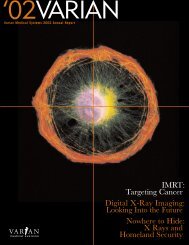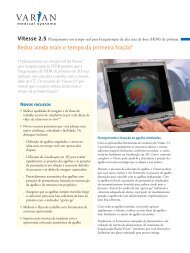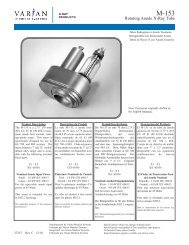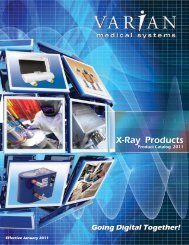Varian Linatron High-Energy X-ray Applications 2007
Varian Linatron High-Energy X-ray Applications 2007
Varian Linatron High-Energy X-ray Applications 2007
You also want an ePaper? Increase the reach of your titles
YUMPU automatically turns print PDFs into web optimized ePapers that Google loves.
Introduction<br />
X-<strong>ray</strong>s are a type of electromagnetic energy that occupies a<br />
particular place in the electromagnetic spectrum. What we<br />
refer to as X-<strong>ray</strong>s is a type of energy that can be understood<br />
as both particles and waves because they have characteristics<br />
of both. Photons are the particle aspect of X-<strong>ray</strong>s, which<br />
are mass-less and travel at the speed of light. These are<br />
produced by <strong>Linatron</strong>s when high energy electrons are<br />
accelerated and strike a high density metal target. This<br />
releases photons in the X-<strong>ray</strong> frequency band as shown in<br />
Fig. 1-1.<br />
FIGURE 1-1. Spectrum<br />
Nondestructive testing using high energy (greater than 1<br />
MeV) radiographic techniques has been in use for more<br />
than 60 years. During this period, a number of highenergy<br />
X-<strong>ray</strong> sources have been developed for the detection<br />
of flaws in heavy metal sections. More recently, these x-<strong>ray</strong><br />
sources have found important uses in cargo screening and<br />
related security inspections applications. Please consult<br />
other <strong>Varian</strong> documentation for information on cargo<br />
screening applications.<br />
The first commercial high-energy X-<strong>ray</strong> source was the 1<br />
MeV resonant transformer, introduced by General Electric<br />
in 1939. A few years later there appeared 2 MeV versions<br />
of the resonant transformer, Van de Graaff generators with<br />
energies of 1 MeV and 2 MeV, and Betatrons with electron<br />
beam energies ranging from 15 MeV to 25 MeV.<br />
page 3<br />
The maximum X-<strong>ray</strong> output of these early machines was<br />
limited. Electron linear accelerators, which became available<br />
commercially about 1956, offered a way to substantially<br />
increase the X-<strong>ray</strong> output and made practical the<br />
radiography of steel sections greater than 2 feet thick. This<br />
met the need of modern nuclear technology which required<br />
radiographic examination of assemblies containing relatively<br />
thick sections of very dense material, such as uranium and<br />
tungsten alloys. Linear accelerators proved capable of<br />
penetrating and recording flaws or other anomalies on x-<strong>ray</strong><br />
film through many inches of such materials.<br />
<strong>Varian</strong> SIP (Security and Inspection Products) first<br />
extended its linear accelerator technology into the highenergy<br />
radiography field in December 1959 with the<br />
delivery to the U.S. Navy of a 10 MeV machine designed<br />
to produce high-quality radiographs of the Polaris missile<br />
and other solid rocket motors. In the years that followed,<br />
<strong>Varian</strong> SIP continued to supply similar machines to<br />
government and industrial customers.<br />
In 1968, <strong>Varian</strong> SIP introduced the <strong>Linatron</strong>®, a line of<br />
industrial linear accelerators with energy ranges from 1 to<br />
15 MeV. The <strong>Linatron</strong> represented a significant advance<br />
in reliability and ease of operation and handling. A typical<br />
<strong>Linatron</strong> installation includes an X-<strong>ray</strong> head (Figs. 1-2 and<br />
FIGURE 1-2. <strong>Linatron</strong> M9 X-<strong>ray</strong> head.<br />
<strong>Varian</strong> <strong>Linatron</strong> applications










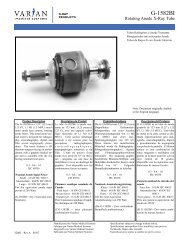
![[MSDS 126] Dow Corning 200 Fluid, 5 CST Part Number ... - Varian](https://img.yumpu.com/5104917/1/190x245/msds-126-dow-corning-200-fluid-5-cst-part-number-varian.jpg?quality=85)

